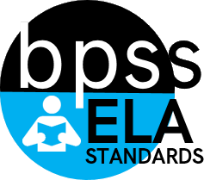ELA-11.RI.06
|
11th Grade ELA Targeted Standards
[RI] Reading Information Strand
Cluster: Craft and Structure
ELA-11.RI.06 Determine an author’s point of view or purpose in a text in which the rhetoric is particularly effective, analyzing how style and content contribute to the power, persuasiveness, or beauty of the text.
|
Student Learning Targets:
Knowledge Targets
- I can determine an author’s point of view or purpose in a text.
- I can define rhetoric.
- I can define various rhetorical devices such as alliteration, allusion, analogy, anaphora, antithesis, apostrophe, asyndeton/polysyndeton, chiasmus, hyperbole/understatement, metaphor, oxymoron, parallelism, rhetorical question, simile, etc.
Reasoning Targets
- I can analyze how an author uses rhetoric to advance the point or purpose.
- I can analyze a case in which grasping point of view requires distinguishing what is directly stated in a text from what is really meant (e.g., satire, sarcasm, irony, or understatement).
- I can compare and contrast the point of view from different works that focus on the same topic.
- I can analyze how style, content, and voice contribute to the power, persuasiveness, or beauty of the text.
Skills (Performance) Targets
- I can identify effective rhetoric and explain what makes it effective.
- I can prepare for a discussion on rhetorical analysis.
Product Targets
- I can write a rhetorical analysis.
Proficiency Scale
|
Measurement
of Progress
|
Craft & Structure
- RI 11-12.4 Determine the meaning of words and phrases as they are used in a text, including figurative, connotative, and technical meanings; analyze the cumulative impact of specific word choices on meaning and tone, including words with multiple meanings or language that creates particular effects.
- RI 11-12.5 Analyze and evaluate the effectiveness of the author’s choices about structure to achieve a particular purpose with an intended audience.
- RI 11-12.6 Determine an author’s point of view or purpose and possible biases in a text, and analyze how the author’s choices about style, content, and presentation are particularly effective or ineffective in achieving the author’s purposes.
|
Sample Activity
|
| Advanced |
In addition to expectations of proficiency, student provides consistent evidence of in-depth inferences and applications that go beyond what was taught and expected.
The student can
-
insightfully analyze meaning and impact of words and phrases and the effects of an author’s choices in structuring a text.
-
thoroughly analyze author’s point of view, cultural experience, and subtext.
-
connect study of literature, its craft and structure, and apply it to his/her own writing.
-
analyze point of view, clearly distinguishing what is directly stated in a text from what is really meant, connecting usage to the author’s purpose.
|
- |
| Proficient |
The student
- determines the meaning of words and phrases as they are used in the text, including figurative, connotative, and technical meanings.
- relates the author‘s word choice and language (including multiple meanings and language that is fresh and engaging) to the overall effect on meaning and tone.
- closely examines specific parts of a text in order to understand how an author structured and crafted that particular part to contribute to meaning or artistic effect.
- determines author’s point of view or purpose and possible biases.
- analyzes effectiveness of style, content, and presentation.
|
- |
| Progressing |
The student demonstrates no major errors or omissions regarding the simpler details and processes but exhibits major errors or omissions regarding the more complex ideas and processes.
The student can
- identify when an author uses fresh and creative language and can recognize elements of a text, but is unable to explain how craft and structure contributes to meaning.
- recognize or recall specific terminology that relates to craft and structure of informational texts, such as: figurative language, connotation, denotation, diction, imagery, irony, sarcasm, ambiguity, point of view, satire, hyperbole, understatement (litote), allusion, pun, rhetoric, ethos, pathos, logos, bias, tone.
|
- |
| Novice |
With help, the student demonstrates a partial understanding of some of the simpler details and processes and some of the more complex ideas and processes. |
- |
Resources
Websites
Vocabulary |

